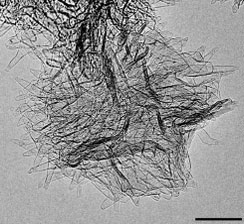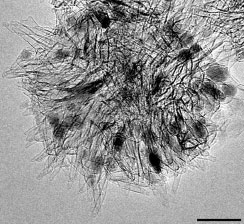| Posted: Apr 28, 2006 | |
Magnetite-labeled carbon nanohorns as low-toxicity MRI agents |
|
| (Nanowerk News) Notwithstanding all the recent publicity about the presumed or actual toxicity of nanomaterials, the detailed pharmacological knowledge of any nanomaterial is important in order to assess its level of toxicity in the living body. While in vivo toxicity assessment of carbon nanotubes (CNTs) is still at the early stage, research in this area is well underway. | |
| In a recent development, researchers in Japan have established a simple method to strongly label CNTs with magnetite nanoparticles, which allowed easy identification of the accumulated location of CNTs in the living body, and also showed low toxicity of the labeled CNTs. Both of these are crucial characteristics for progressing the pharmacological applications of CNTs. | |
| The researchers, working at the Iijima group at Japan Science & Technology Agency (JST) have developed a simple method for strongly attaching nanoparticles (6 nm in diameter) of Fe3O4 to one type of CNTs, hole-opened single-walled nanohorns (SWNHs). The attached magnetite nanoparticles induced remarkable darkening of the MR images, which allowed in vivo visualization of the accumulative behavior of SWNHs in the spleen and kidneys. Preliminary results confirming the low toxicity of magnetite-attached NHs were also presented. | |
| Dr. Jin Miyawaki explained the rationale for their research to Nanowerk: "CNTs have found applications in the biomedical field such as biosensors, ion-channel blockers, and agents for selective cancer-cell destruction. They are also potentially useful as carriers of drugs, proteins, and genes. It is indispensable, however, to elucidate toxicological and pharmacological properties of CNTs before their clinical application." | |
| Among some other labeling materials, such as radioactive isotopes and paramagnetic gadolinium-ion complexes, magnetite nanoparticles have low health and environmental risks, but no method for strong attachment of magnetite nanoparticles to CNTs has been investigated. | |
| "In our recent report" says Miyawaki, "we presented an easy method to study biodistribution and accumulation profiles of administrated CNTs in living body using noninvasive magnetic resonance imaging (MRI) technique, that is, labeling CNTs with superparamagnetic magnetite nanoparticles." | |
| Miyawaki, who first-authored the paper, together with Dr. Masako Yudasaka, Dr. Hideto Imai, Dr. Hideki Yorimitsu, Dr. Hiroyuki Isobe, Professor Eiichi Nakamura, and Professor Sumio Iijima published their recent findings, titled "In Vivo Magnetic Resonance Imaging of Single-Walled Carbon Nanohorns by Labeling with Magnetite Nanoparticles" in the April 7, 2006 online edition of Advanced Materials. | |
  | |
| TEM images of left: oxidized nanohorns (oxNHs); and right: magnetite attached to oxNHs (MAGoxNHs). Scale bars: 20 nm. (Reprinted with permission from Wiley) | |
| In their experiments, the researchers attached Fe3O4 nanoparticles to SWNHs through a thermal transformation of Fe(OAc)2 clusters, which were deposited on oxNHs in ethanol at room temperature. Miyawaki and his colleagues theorize that the strong attachement of the superparamagnetic magnetite nanoparticles to the oxNHs is due to a thin iron carbide layer, which might form at the applied temperature of 400°C at the interface between the nanoparticles and the oxNHs. | |
| The simple method for attaching magnetite developed by the Japanese researchers is applicable to other types of CNTs and can therefore be expected to facilitate the health-risk assessment of various types of CNTs using in vivo MRI. | |
| "Such information is indispensable for the fabrication of nanotubular carbonaceous materials designed for applications in biomedical science and biotechnologies" says Yudasaka. "In addition, the carbonaceous sheath around magnetically active particles would also provide a platform for organofunctionalization, which may enable future applications in magnetoswitching materials." | |
 By
Michael
Berger
– Michael is author of three books by the Royal Society of Chemistry:
Nano-Society: Pushing the Boundaries of Technology,
Nanotechnology: The Future is Tiny, and
Nanoengineering: The Skills and Tools Making Technology Invisible
Copyright ©
Nanowerk LLC
By
Michael
Berger
– Michael is author of three books by the Royal Society of Chemistry:
Nano-Society: Pushing the Boundaries of Technology,
Nanotechnology: The Future is Tiny, and
Nanoengineering: The Skills and Tools Making Technology Invisible
Copyright ©
Nanowerk LLC
|
Become a Spotlight guest author! Join our large and growing group of guest contributors. Have you just published a scientific paper or have other exciting developments to share with the nanotechnology community? Here is how to publish on nanowerk.com.
